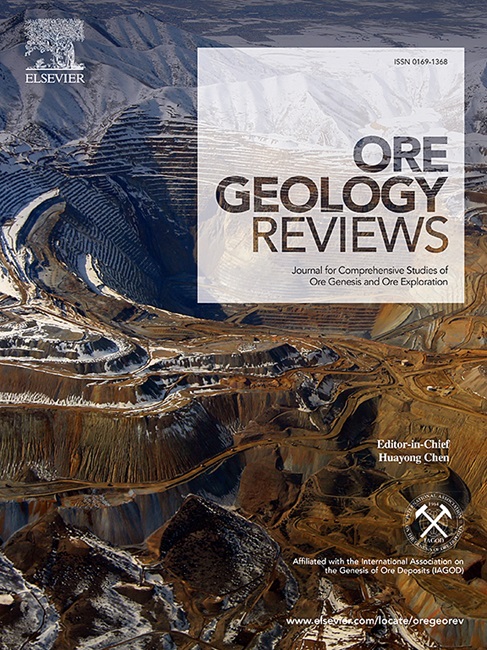利用钡同位素区分金矿床的变质流体和岩浆流体
IF 3.2
2区 地球科学
Q1 GEOLOGY
引用次数: 0
摘要
成因型金矿床和侵入型金矿床是全球最重要的两类金储量,合计占总储量的一半以上,分别与变质流体和岩浆含水流体有关。从理论上讲,金矿床应该是变质流体和岩浆含水流体活动的结果,这些流体是金的来源、载体和保留地。然而,区分变质流体和岩浆流体之间的差异具有挑战性,这主要是因为硫化物的微量元素、S 和 Re-Os 同位素与成矿流体的 C、H、O、He 和 Ar 同位素存在重叠。钡作为一种对流体敏感的阳离子,被认为可以忠实地记录流体的来源和演化过程。在这项工作中,我们展示了华北克拉通北缘哈达门金矿床和郝尧尔湖东金矿床中各种矿岩的钡同位素。这两个矿床的成矿流体已经明确,分别来源于碱性花岗岩岩浆中的晶体-熔体分离以及变质过程中黑色销售中绿泥石和云母的脱水。在上述两个金矿床的不同矿岩中,Ba 同位素呈现出明显的分馏现象。随着SiO2含量的增加,δ138/134Ba值从硅酸钾盐蚀变带的-0.28‰,越过充满硫化物-石英脉的硅酸钾盐蚀变带的-0.21‰∼-0.19‰,增加到硫化物-石英脉的-0.13‰∼+0.01‰。这表明,较重的钡同位素主要是由于K长石和重晶石的结晶而优先加入到演化的岩浆流体中的。相反,δ138/134Ba值从碳质板岩(+0.73 ‰ ∼ +0.95%)下降到硫化物矿脉(-0.28 ‰ ∼ +0.07‰),然后又上升到硫化物-石英矿脉(+0.01 ‰)。这一现象是由于伴随变质作用,成岩重晶石的溶解不断增强,以及变质流体演化过程中重晶石的结晶。显微结构特征也支持重晶石的结晶和溶解控制了两种不同特征流体中显著的钡同位素分馏。此外,岩浆流体和变质流体中的钡含量与δ138/134Ba值之间分别呈现出相对的正负关系。这些地球化学特征也有助于确定成矿流体的来源。因此,我们提出,Ba同位素组成将成为解读含金成矿流体演化过程和区分成矿流体成因的新工具。本文章由计算机程序翻译,如有差异,请以英文原文为准。

Using barium isotopes to distinguish metamorphic and magmatic fluids for the gold deposits
The orogenic and intrusion-related gold deposits represent the two most significant types of gold reserves globally, collectively accounting for over half of the total and are formed associated with metamorphic and magmatic hydrous fluids, respectively. Theoretically, gold deposits should be a result of activities of the metamorphic and magmatic hydrous fluids that sourced, carried, and reserved gold. However, distinguishing differences between the metamorphic and magmatic fluids proves challenging mainly due to overlapping of trace elements, S, and Re-Os isotopes of sulfides and C, H, O, He, and Ar isotopes of the ore-forming fluids. Barium, as a fluid sensitive cation, is believed to faithfully record the sources and evolution of fluids. In this work, we presented the Ba isotopes of various ore-rocks from the Hadamen and Haoyaoerhudong gold deposits along the northern margin of the North China Craton. These two deposits have been well-defined the ore-forming fluids that originated from crystal-melt separation in alkaline granitic magma and dehydration of chlorite and mica from the black sales during metamorphism, respectively. The Ba isotopes exhibit significantly fractionation among the various ore-rocks from above two gold deposits. With increasing SiO2 content, δ138/134Ba values increased from −0.28 ‰ in the potassium silicate alteration zone, crossed −0.21 ‰ ∼ −0.19 ‰ in the potassium silicate alteration zone filled with sulfide-quartz veins, to −0.13 ‰ ∼ +0.01 ‰ in the sulfide-quartz veins. This suggests that the heavier Ba isotopes were preferentially incorporated into the evolving magmatic fluids primarily due to the crystallization of K-feldspar and barite. In contrast, δ138/134Ba values decreased from the carbonaceous slate (+0.73 ‰ ∼ +0.95 %) to sulfide veins (−0.28 ‰ ∼ +0.07 ‰), then increased to sulfide-quartz veins (+0.01 ‰). This phenomenon results from the continuously enhanced dissolution of diagenetic barite accompanying metamorphism and the crystallization of barite during evolution of metamorphic fluids. The microstructural characteristics also support that crystallization and dissolution of barite control significant Ba isotope fractionation in two types of fluids with different features. Furthermore, the magmatic and metamorphic fluids exhibit relative positive and negative relationships between Ba content and δ138/134Ba values, respectively. These geochemical features are also useful in defining the origin of the ore-forming fluids. Therefore, we propose that Ba isotope composition will be a new tool for deciphering the evolution of the Au-bearing ore-forming fluids and distinguishing the origin of the ore-forming fluids.
求助全文
通过发布文献求助,成功后即可免费获取论文全文。
去求助
来源期刊

Ore Geology Reviews
地学-地质学
CiteScore
6.50
自引率
27.30%
发文量
546
审稿时长
22.9 weeks
期刊介绍:
Ore Geology Reviews aims to familiarize all earth scientists with recent advances in a number of interconnected disciplines related to the study of, and search for, ore deposits. The reviews range from brief to longer contributions, but the journal preferentially publishes manuscripts that fill the niche between the commonly shorter journal articles and the comprehensive book coverages, and thus has a special appeal to many authors and readers.
 求助内容:
求助内容: 应助结果提醒方式:
应助结果提醒方式:


